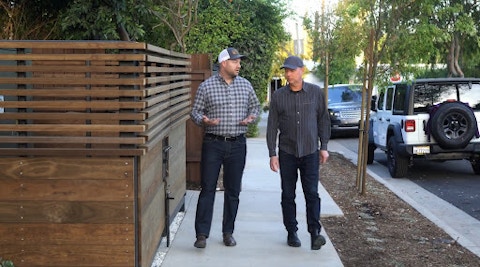More About This Episode
The Smarter Building Materials Marketing podcast helps industry professionals find better ways to grow leads, sales and outperform the competition. It’s designed to give insights on how to create a results-driven digital marketing strategy for companies of any size.
Ben Roberts is the North American Marketing Director for Kebony, a manufacturer of wood cladding that recently won several 2020 Telly Awards for their Design vs. Build series. Ben shares everything from how they produce the stunning videos that have become part of what makes Kebony such a successful building materials brand to how they use the videos to drive leads and sales.
Building a Brand With Video
Ben started his career in marketing, for a local lumber yard hiring a marketing specialist — a somewhat vague title that allowed Ben a bit of freedom in the position. He’d been interested in using video content to help promote his company’s brand because he recognized the impact that video can have on an audience. But that’s not always easy in building materials.
“I knew that, when you're marketing any sort of building material, you really need to get to the finished product, which is hard because you're so many places removed,” says Ben. “I just started reaching out to deck builders and whoever else was using our product, just so I could get photos of it.”
He wanted to test his theory that video would make an even bigger impact on the brand and telling its story. “I purchased a video camera, and eventually got a videographer,” explains Ben. He started a video series called Timber Tips, with episodes about decking, wood types and other common topics in the lumber world.
“That really kicked me off on what the potential of video could do,” says Ben. He wanted to experiment a little bit more and developed plans and ideas for other videos.
A few years ago, Ben was approached by the team at Kebony — a wood product sold at the lumber yard Ben worked for. Kebony wanted him to join their marketing team.
Ben told them, if hired, “the first thing I'm going to do is start investing heavily in video." Ben was dedicated to telling Kebony’s story and wanted to enhance what the company had done with the brand so far.
“I was able to build the time around what we were doing, and really look for ways that we could make building materials and that manufacturing side different than all of our competitors,” explains Ben.
The Secret to Kebony’s Success
Ben knew that he wanted to invest in video marketing in a big way, and came to Kebony with even bigger, bolder plans. “I came up with an idea that I had tried to pitch when I was at Timber Town, and it was this idea of design versus build,” explains Ben.
Kebony’s biggest demographics are architects and builders, and the premise of the video is very audience-focused. “Oftentimes, you'll hear from an architect and they are very easy to talk to about the project because they are bringing all the vision. But, it's the builders who have to make that vision a reality,” explains Ben. Each video features a project and interviews with the architect and builder on the project.
But there’s something unique about Kebony’s Design vs. Build series, which might contribute to it being an award-winning series. “The main part of the show, and the thing that we started from the very beginning, was we did not want this to be a Kebony commercial,” explains Ben.
“In fact, we don't say Kebony in the video once,” says Ben.
Is your jaw on the floor, too? It’s this piece of information that makes the Design vs. Build series so unique — and more impactful on the viewing audience.

“We will show a project that has Kebony on it. But if one of the interviewees, the builder or the architect or the developer says Kebony, we cut that part out because we wanted people to see the value in the video and the content itself, and not ever feel like we were creating a commercial,” Ben explains.
The series works on its own, independently of the Kebony brand, since Kebony isn’t mentioned. “Because of that, I think we've been able to publicize it and get it into the hands of more people. So we'd get it in publications, trade magazines, we'll publish the videos, and it's because we're taking this very independent approach,” says Ben.
Because the project was independent, Kebony was able to get it onto a streaming application called Shelter. “So it's on a streaming service called Shelter, which is just architect and design-driven videos. We're able to put it on there as well. It helps us reach a much bigger audience than we normally would have because we've decided to make it such an independent piece,” says Ben.
The Design vs. Build videos won several Telly awards in 2020. The Telly Awards is a video and television award competition between some of the biggest brands around the globe. Kebony beat out CNN, BBC and Conde Nast with its Design vs. Build series.
Video marketing can certainly be an investment, and Ben knew his idea was a little risky. “But, we knew that people were valuing content more than they were valuing commercials. If we're going to invest in anything, we want it to be an investment in something that people are finding value in, even beyond the building industry,” says Ben.
Strategies for Video Marketing
The Design vs. Build videos are visually stunning, but in order for a high-quality video to be an effective marketing tool, there needs to be a strategy. Because that strategy can open your pipeline up for sales, even if you’re creating videos for a wide audience. Ben talked us through some of the planning behind Design vs. Build.
Website
“Before we started this, we redid our website and made sure that it was going to be optimized for gathering as many leads as possible. Because if we're gaining an audience, it's of no use to us on the marketing side from Kebony if we can't actually measure any sort of leads coming off of that.”
Calls-to-Action
“If we were just making these beautiful videos and winning these awards, but we never had any call-to-action when people were curious about Kebony, then we are losing a lot of the leads that we could potentially have.”
Lead Funnels
“Everything that, whether it's other videos that we create or any sort of social media or whatever else, it's going to the website. On the website, we take a very content-heavy approach. We're focusing on content marketing and lead generation through forms. The very first form that people typically get is the product guide, which is an email lead, that's just the very basic.”
Cross-Promotion
“The beauty of this series,” says Ben, “is that we are really making some of our top customers customers-for-life, because they see the marketing power and production power that we're putting into this video. And if they're trying to decide if they're going to use Kebony or a competitor, and they know they could potentially have a Design Vs Build episode done about their project … it makes it a really easy decision for them.”
It can be hard for manufacturers to measure the ROI of video marketing, especially when so much goes into production (especially a series like Design vs. Build). “I really put that show at a very high level, in terms of the funnel. That is hitting the widest audience that we could have, and really hitting people that they may never buy our products,” explains Ben. “But that's okay because it's also being shared with people that would.”
In fact, the Design vs. Build series currently has more than a quarter-million views on YouTube today.

Want Even More Insight?
Ben has some final tips for those of you who might be starting out with video marketing.
“I would say the first thing you have to look at is what's going to be valuable to your customers, and sometimes that can be answered by: What would you watch? What would you want to see, if you were following a brand that you particularly loved, what would you like to see them create for you?” explains Ben.
More and more building materials brands are experimenting with video, and since most people have smartphones today, that’s gotten quite a bit easier for brands. We can’t wait to see what 2022 means for building materials and video marketing.
Check out Design vs. Build to see Kebony’s award-winning series for yourself. You can also follow them on Instagram.
Enjoy the episode? Check out all of our podcast episodes for more tips on marketing your building materials business in 2022 and beyond.








